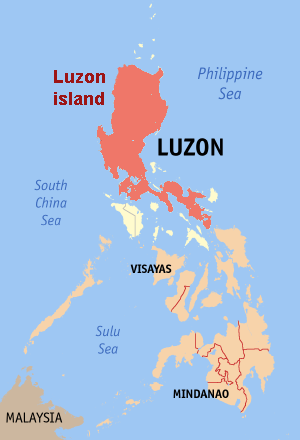Luzon
THE ISLAND OF LUZON is the largest and most populous island in the PHILIPPINE archipelago (17th largest in the world), the center of Philippine political and economic life, and the site of the capital city, MANILA. With roughly 42 million people occupying a total land area of 40,420 square mi (104,688 square km)—roughly the size of VIRGINIA, with nearly 10 times the population—Luzon has one of the highest population densities in the world, in large part because of the fertility of its volcanic soil and abundant rainfall.
Luzon is also one of the most Europeanized areas in Asia, thanks to its convenient location at the western terminus of the Pacific TRADE ROUTES used continuously by the Spanish from the early 16th century. Spanish language and religion dominated the island for the next three centuries, until the islands came under the influence of the UNITED STATES at the end of the 19th century. Luzon is divided into seven regions, each with numerous provinces (30 total on Luzon), and three cities with over 1 million people: Quezon City (2.17 million), Manila (1.6 million), and Caloocan City (1.2 million).

The island is the northernmost in the Philippine group, with the exception of the smaller Batan and Babuyan islands in the Luzon Strait. This strait separates the Philippines from TAIWAN by about 220 mi (370 km). To the east lies the Philippine Sea (part of the PACIFIC OCEAN, bounded by the northern MARIANA ISLANDS, GUAM, Yap, and PALAU), and the South China Sea lies to the west.
The southern coasts of the island border the complex Sibuyan Sea lying between the nearby islands of Mindoro, Masbate, Samar, and Visayan. Formed about 50 million years ago from a combination of volcanoes and the buckling of the Earth's crust, Luzon lies along one of the most active edges of the RING OF FIRE, which extends northward from Sulawesi, INDONESIA, to JAPAN.
The Philippine Trench lies just off the east coast of Luzon, marking the convergence zone of the Philippine and Asian tectonic plates. The trench runs parallel to the island its entire length, plunging to depths of 33,000 ft (10,000 m). A number of Luzon's mountains are volcanoes, including its most active, Mayon (7,943 ft or 2,407 m), which last erupted in January 2004 and rivals Mount Fuji, Japan, in perfection of its symmetry. Mount Pinatubo (4,874 ft or 1,477 m), northwest of Manila, erupted in June 1991 and devastated an area of 154 square mi (400 square km), blanketing much of Southeast Asia with ash. Modern prediction techniques, however, prevented a potentially massive loss
of life, and the death toll reached only 250.
The island is a construction of these volcanic chains and owes its erratic shape to this; it is essentially two landmasses: the larger northern portion and the narrower extension to the southeast, the Bicol Peninsula, connected to the rest of Luzon by the Tayabas Isthmus, which is only 8 mi (13 km) wide at points. The Zambales mountain range forms the westernmost part of the island.
Two mountain chains dominate the northern part of the island, the Cordillera Central—including the highest peak, Mount Pulog (9,682 ft or 2,934 m)—and the Sierra Madre along the northeast coast. In these mountains are some of the most inaccessible human populations on Earth, including the Bontoc and other mountain peoples. Another mountain chain forms the Bicol Peninsula. The longest river on Luzon flows between the Cordillera and the Sierra Madre, the Cagayan, which is navigable for a considerable distance and has potential for hydroelectrical power. The most important river for traffic and commerce is, however, the much shorter Pasig, which flows through Manila, and links Leguna de Bay (the country's largest lake) with Manila Bay.
Luzon has mineral wealth, including two of the principal gold mines in the Philippines, in Mountain Province and Camarines Norte. Other resources include copper, asbestos and chrome. But the island is primarily an agricultural producer, mostly of rice, but also corn, tobacco, sugar, cotton, and several tropical products (coconut, mango, banana, cacao, etc). Nearly all industries are concentrated in Greater Manila. The people are related ethnically and linguistically to Malays; Tagalog, the dialect spoken in the region around Manila, became the official national language (called Filipino).
From conquest by SPAIN in the 1520s, the island was developed by large plantations (mostly in the north of the island, where there is the flattest land); using mostly forced labor, the Spanish produced tobacco at first, followed by sugar, coffee, indigo, and pepper—to compete with exports from the Dutch East India Company. Missionaries naturally followed, and the island was 80 percent Catholic by the time of the U.S. occupation in 1898. The island retains much of its Spanish culture, despite the growing influence of British and American traders from earlier in the century. Status as a U.S. protectorate was generally beneficial to the island in many respects, for example in literacy, which was five times the rate of neighboring INDONESIA by the 1940s. The U.S. naval base at Subic Bay and Clark Air Base provided numerous jobs and economic activity. Hopes for transforming this area into a free trade zone since the bases' closure in 1992 have so far failed to materialize. Christian Luzon also faces increasingly hostile separatist movements from the Muslim-dominated southern islands.